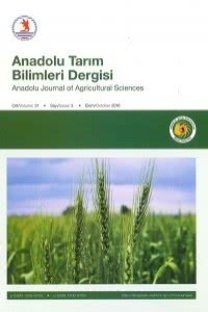Japon bıldırcınlar yumurta kabuk kalınlığı, gözenekliliği ve yumurta ağırlık kaybının kuluçka sonuçlarına etkileri
Bu araştırma Japon bıldırcınlarında yumurta kabuk kalınlığı, gözenekliliği ve yumurta ağırlık kaybının kuluçka sonuçlarına etkilerini belirlemek amacıyla yapılmıştır. Beş gün içerisinde toplanan 477 adet yumurta, kuluçka makinasına bireysel ağırlıkları saptanarak konulmuş ve kuluçkanın 5., 10., 14. ve 18. günlerinde de bireysel olarak tartılmış ve bu günlerdeki ağırlıkları ile iki süre arasındaki ağırlık kayıpları belirlenmiştir. 18. gün sonunda, çıkış olan (Ç), erken embriyo ölümü (EEÖ), geç embriyo ölümü (GEÖ), kabuk altı ölümü (KAÖ) ve dölsüz (D) olmak üzere beş tip yumurtada kabuk kalınlığı ve gözenekliliği saptanmıştır. Kuluçkanın 14. gününe kadar olan bütün periyodlarda ağırlık kaybı EEÖ grubunda en yüksek; GEÖ ve D gruplarında orta düzeyde, Ç ve KAÖ gruplarında ise düşük oranda belirlenmiştir (P
Effects of shell thickness, shell pores and egg weight loss on hatchablity on japanese quail eggs
This study was conducted to determine the effects of eggshell thickness, pores, and weight loss on hatchability of Japanese quail eggs. A total of 477 eggs, collected within 5 days, placed in an incubator after determining individual egg weights, and eggs were individually weighted on 5,1İ0,14, and 18th days of incubation. Percentage egg weight loss was calculated for individual eggs for each incubation interval. On day 18 of incubation, all unhatched eggs were opened and examined macroscopically for evidence of stage of embryonic development. Egg types were classified as infertile (INF), early dead (ED), late dead (LD), embryos that pipped the shell but failed to emerge (PIP) and hatched (H). Dry chicks weights from hatched eggs were obtained on day 18. Shell thickness and porosity were determined in all egg types. The greatest egg weight loss until the day 14 of incubation was observed in ED eggs;it was intermediate in LD and INF eggs, whereas it was low in H and PIP eggs (PO.05), The egg weight loss between 14-18 days was high in H and ED eggs, and low in other types of eggs (P<0.05).The egg weight loss between 0-18 days were observed in all egg types (H: %29.26±0.26, ED: %25.00i2.05, LD: %18.77±0.77, PIP: %15.04±1.40, and INF: %16.41 ±1.22; P<0.05). In three different eggshell regions (air space, equator, small end), a high number of pores was observed in H eggs, and the number of pores was low in PIP eggs (PO.05). The lowest shell thickness was observed in air space and small end region of ED eggs, and in equator regions of PIP eggs (PO.05).
